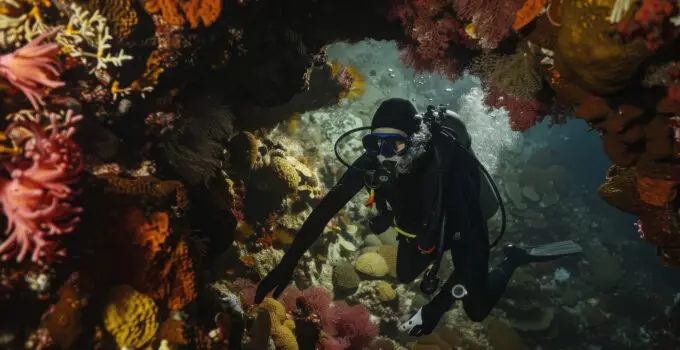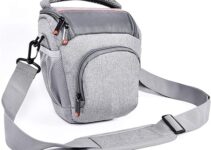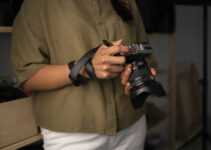Wondering if you can take your camera for a swim in a plastic bag? It’s a curious question for anyone venturing into underwater photography.
Can this simple hack really protect your camera from water damage?
In short, yes, you can protect your camera in a plastic bag underwater. But, is it foolproof? What are the risks and limitations?
Dive deeper into our comprehensive guide to understand the dos and don’ts of using a plastic bag as a makeshift waterproof housing for your camera.
Join us as we explore expert insights and practical tips from renowned underwater photographers.
Discover the best practices and alternative options for safeguarding your camera while capturing stunning underwater shots.
Can i stick my camera in a plastic bag underwater?
How do you secure a camera underwater?
Can I use my camera underwater?
Do plastic bags protect phones from water?
Plastic bags can offer some level of protection against water for phones, but they are not reliable or recommended for long-term or deep-water use.
Here’s why:
- Limited Waterproofing: Plastic bags are not designed to be waterproof like specialized phone cases or pouches. They may provide temporary protection against light splashes or rain, but they can easily leak or tear under pressure.
- Condensation and Moisture: Moisture can accumulate inside the bag due to condensation, especially in humid environments or when the phone generates heat during use. This moisture can potentially damage the phone over time.
- Touchscreen Functionality: Plastic bags can hinder touchscreen functionality, making it difficult to use the phone effectively while it’s inside the bag.
For more reliable water protection, it’s best to use a purpose-built waterproof phone case or pouch that provides a secure and waterproof seal specifically designed for your phone model.
Are Ziploc bags completely waterproof?
Ziploc bags are not completely waterproof in all situations.
While they can offer a level of water resistance, especially against light splashes or brief exposure to water, they are not designed to be fully submersible or to withstand prolonged water exposure.
Here are some factors to consider:
- Seal Integrity: Ziploc bags rely on a zipper seal to keep water out. However, this seal may not be completely airtight or waterproof, especially if the bag is not closed properly or if there are any tears or damage to the seal.
- Material Thickness: The thickness of the plastic material used in Ziploc bags can vary. Thicker bags may offer better water resistance compared to thinner ones, but they are still not designed for deep water submersion.
- Pressure and Duration: Ziploc bags can handle light water exposure or moisture, but they may leak under pressure or when submerged for extended periods.
For more reliable waterproofing, especially for valuable items like electronics or documents, it’s advisable to use purpose-built waterproof bags or containers that are designed to withstand water immersion and have a secure, waterproof seal.
Is it Safe to put camera in ziplock bag?
How to test a used housing & change lenses?
To test a used camera housing, follow these steps:
- Visual Inspection: Check for any cracks, scratches, or signs of damage on the housing’s exterior and seals.
- Seal Test: Close the housing without the camera inside and submerge it in water. Look for air bubbles, which indicate leaks.
- Pressure Test: Place the closed housing in a bathtub or pool for a few minutes to test its waterproof integrity under pressure.
To change lenses on an underwater housing:
- Remove the housing from water.
- Open the housing carefully, avoiding water ingress.
- Swap lenses following manufacturer instructions.
- Close the housing, ensuring seals are clean and properly aligned.
Storing camera gear in plastic bag with dessicant or not in humid conditions?
Storing camera gear in humid conditions requires precautions to prevent moisture damage:

- Plastic Bag with Desiccant: Placing camera gear in a sealed plastic bag with a desiccant can help absorb moisture and protect against humidity. The desiccant absorbs excess moisture, reducing the risk of mold, corrosion, and fogging on lenses.
- Proper Seal: Ensure the plastic bag is sealed tightly to prevent moisture from entering. Double-bagging or using a moisture-proof camera bag can provide added protection.
- Regular Checks: Periodically check the desiccant’s effectiveness and replace it as needed to maintain a dry environment.
- Alternative Storage: Consider using a dry box or cabinet with a dehumidifier for long-term storage in humid conditions. These provide a controlled environment with low humidity levels, ideal for protecting sensitive camera equipment.
By taking these measures, you can help prolong the lifespan of your camera gear and maintain optimal performance, especially in humid climates.
Is it safe to use a ziplock bag (or two) with a compact camera for underwater photography in a pool?
Using one or two Ziplock bags with a compact camera for underwater photography in a pool can be a risky choice.
While Ziplock bags may offer some level of water resistance against splashes and minor submersion, they are not designed for underwater photography, especially in a pool environment.
Here are some considerations:
- Limited Waterproofing: Ziplock bags are not completely waterproof and may leak, especially under pressure or prolonged submersion.
- Impact on Image Quality: The plastic of the Ziplock bags can distort images, affecting the clarity and color accuracy of your underwater photos.
- Risk of Damage: If water does seep into the bag, it can damage the camera’s electronics, potentially leading to costly repairs or the need for a replacement.
For safer and higher-quality underwater photography in a pool, it’s recommended to use a dedicated underwater camera housing specifically designed for your compact camera model.
These housings provide a secure and waterproof seal, ensuring the safety of your camera and maintaining image quality underwater.
9 Steps to stick my camera in a plastic bag underwater
Step 1: Select a Quality Bag
Choosing the right plastic bag is crucial for underwater photography.
Opt for a thick and durable plastic bag that can withstand water pressure and is large enough to comfortably accommodate your camera. Avoid using thin or flimsy bags as they are more prone to tearing and leaking.
Look for bags with a reliable seal, such as Ziplock bags or sealable freezer bags, to ensure a tight closure underwater.
Step 2: Prepare the Bag
Before inserting your camera, inspect the plastic bag for any defects or damages. Check for holes, tears, or weak spots that could compromise its waterproofing ability.
Ensure the bag is clean and free from any debris or contaminants that could potentially harm your camera or affect image quality underwater.
Wipe the inside of the bag with a clean, dry cloth to remove any moisture or particles.
Step 3: Insert Camera
Carefully place your camera inside the prepared plastic bag.
Position the camera in the center of the bag to ensure even coverage and to prevent it from shifting or moving around during use.
Make sure the camera is powered off and any protruding parts, such as the lens or buttons, are safely enclosed within the bag.
Check that all camera controls are accessible through the bag’s material for easy operation underwater.
Step 4: Add Desiccant (Optional)
Consider including a desiccant packet inside the plastic bag to absorb moisture and reduce the risk of condensation forming inside the bag.
Desiccants help maintain a dry environment, preventing water vapor from affecting your camera and lens.
Place the desiccant packet strategically within the bag, ensuring it does not obstruct the camera or interfere with its functionality.
This step is particularly useful for preventing fogging on the lens and maintaining clear, sharp images underwater.
Step 5: Seal the Bag
Once your camera is securely inside the plastic bag, seal the bag tightly to create a waterproof barrier.
Use the bag’s built-in seal, such as a zipper lock or press-to-seal closure, to ensure a snug and watertight fit around the camera.
Remove any excess air from the bag before sealing it to minimize buoyancy and prevent the bag from floating or shifting during underwater use. Press firmly along the seal to ensure it is fully closed and secure.
Step 6: Double-Bagging (Optional)
For added protection against leaks and water ingress, consider double-bagging your camera.
Place the sealed plastic bag containing your camera inside a second plastic bag of similar size and type.
Seal the outer bag securely using the same method as the inner bag.
Double-bagging adds an extra layer of waterproofing and can provide additional peace of mind, especially when submerging the camera to greater depths or for extended periods underwater.
Step 7: Test for Leaks
Before taking your camera underwater, perform a leak test to ensure the plastic bag is properly sealed and waterproof. Fill a sink or basin with water and submerge the sealed bag completely.
Observe the bag closely for any air bubbles escaping from the seal or seams, as this indicates a potential leak.
Allow the bag to remain submerged for a few minutes to thoroughly test its waterproof integrity.
Step 8: Remove Air Bubbles
If you notice any air bubbles escaping from the bag during the leak test, carefully remove the bag from the water without allowing water to enter.
Open the bag and inspect the seal for any signs of damage or misalignment. Re-seal the bag tightly, ensuring all edges are pressed firmly together to eliminate gaps and prevent leaks.
Repeat the leak test until no air bubbles escape, indicating a properly sealed and waterproof bag.
Step 9: Underwater Photography
Once the plastic bag has passed the leak test and is confirmed to be waterproof, you can proceed with underwater photography.
Submerge the sealed bag containing your camera underwater, ensuring it remains securely sealed throughout the shooting session.
Use the camera’s controls and functions as usual, taking care not to apply excessive pressure or force on the bag to avoid compromising its waterproofing.
Monitor the bag periodically for any signs of leaks or water ingress during use, and avoid prolonged submersion or exposure to water currents that could compromise the bag’s integrity.
After completing your underwater photography session, carefully remove the camera from the bag and inspect both the camera and bag for any signs of water damage or moisture accumulation.
Dry the camera and bag thoroughly before storing them to prevent mold, corrosion, or other issues.
By following these nine steps, you can effectively use a plastic bag for underwater photography with your camera.
However, keep in mind that while this method can provide basic protection and is suitable for casual underwater shots in controlled environments like a pool, it is not as reliable or secure as using a dedicated underwater camera housing specifically designed for your camera model.
Professional underwater photographers or those engaging in extensive underwater photography should invest in proper waterproof camera housings for optimal results and equipment protection.
7 uses of plastic bag and frozen cameras
1. Emergency Waterproofing
Plastic bags can serve as a quick emergency solution to protect a frozen camera or other electronic devices from water damage.
If your camera gets unexpectedly soaked or exposed to rain or snow, immediately place it inside a plastic bag to create a barrier against moisture.
This can help prevent water from seeping into sensitive components and causing short circuits or corrosion.
However, it’s important to note that this is a temporary measure, and you should properly dry and inspect the camera as soon as possible to avoid long-term damage.
2. Moisture Control during Thawing
When dealing with a frozen camera, moisture control is crucial to prevent condensation buildup as it thaws.
Place the frozen camera inside a sealed plastic bag before bringing it back to room temperature.
The bag helps contain the condensation within a controlled environment, reducing the risk of moisture reaching internal components.
Once the camera has thawed completely, carefully remove it from the bag and wipe off any remaining moisture with a soft, dry cloth before using it.
3. Protection from Dust and Debris
Plastic bags can also shield a frozen camera from dust, dirt, and debris while it’s not in use.
If you need to store the camera temporarily in a dusty or dirty environment, place it inside a sealed plastic bag to keep contaminants away.
This is especially beneficial for outdoor photographers who may encounter rugged conditions or windy environments where dust and debris can easily enter camera crevices.
4. Transporting Frozen Equipment
When transporting a frozen camera or related gear, such as lenses or batteries, use plastic bags to organize and protect them.
Separate components into individual bags to prevent them from scratching or rubbing against each other during transit.

This not only keeps the equipment secure but also adds an extra layer of protection against external elements like moisture, dust, and minor impacts.
5. Insulation in Extreme Cold
In extremely cold temperatures, plastic bags can act as insulation to help maintain a slightly higher temperature around the frozen camera.
This can be particularly useful in frigid environments where prolonged exposure to cold air can exacerbate freezing issues.
However, it’s essential to monitor the camera’s temperature and avoid overheating by periodically allowing airflow or removing excess insulation as needed.
6. Temporary Lens Protection
If you need to change lenses on a frozen camera outdoors, use a plastic bag as a makeshift shield to protect the camera’s sensor and interior from snow, moisture, or wind gusts.
Before swapping lenses, carefully place the camera inside the bag, leaving the lens mount exposed.
This creates a barrier to minimize direct exposure to external elements, reducing the risk of damage or contamination during the lens-changing process.
7. DIY Ice Pack for Cooling
In situations where you need to cool down a camera or equipment due to overheating, you can create a makeshift ice pack using a sealed plastic bag filled with ice cubes or a frozen gel pack.
Place the frozen bag near the camera or equipment (not directly touching it) to provide a cooling effect.
This can be handy during outdoor shoots in hot climates or when using equipment that tends to heat up quickly, such as video cameras or lighting gear.
Ensure the bag is securely sealed to prevent water leakage or condensation from reaching the camera.
Related faq’s
Can I use any plastic bag to waterproof my camera?
Not all plastic bags are suitable for underwater use. Look for specifically designed underwater camera bags that are waterproof and durable to ensure your camera’s safety.
How do I ensure a tight seal when using a plastic bag for underwater photography?
Make sure to expel all excess air from the bag before sealing it. Double-check the seal to ensure no water can enter during submersion.
Will using a plastic bag affect the quality of my underwater photos?
While using a plastic bag can provide basic waterproofing, it may slightly distort the image quality compared to using a purpose-built underwater housing. Consider this trade-off depending on your photography needs.
Are there specific precautions I should take when using a camera in a plastic bag underwater?
Avoid sudden temperature changes that can cause condensation inside the bag. Also, be mindful of sharp objects that could puncture the bag during use.
How deep can I safely submerge my camera in a plastic bag?
The depth limit depends on the quality and design of the plastic bag. Follow the manufacturer’s guidelines for maximum depth ratings to prevent water damage to your camera.
Conclusion:
In conclusion, while it’s technically possible to place your camera in a plastic bag and submerge it underwater, it’s not a recommended practice for anything beyond very shallow depths or quick dips.
Plastic bags lack the robust waterproofing and durability of specialized underwater camera housings, making them unreliable for prolonged underwater use.
For reliable and secure underwater photography, investing in a dedicated waterproof camera housing designed for your specific camera model is the best approach.
These housings provide a watertight seal, protection against water pressure, and maintain image quality, ensuring a safe and enjoyable underwater photography experience.







